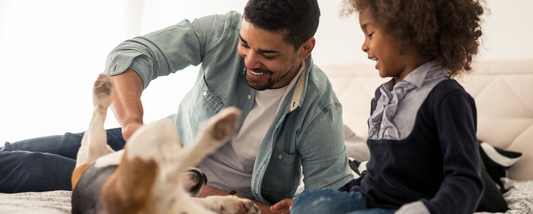It's cold and flu season, which means it's important to protect yourself against viruses and bacteria. But what about your furry friend? Can dogs get the flu? And what can you do to help if they do?
Canine Influenza
Your dog can get the flu. However, he can't get it from you. Human flu viruses can't be spread to dogs, or vice versa, so even if you're sick, your canine companion can still be there to comfort you.
Dogs have their own type of flu, though, called canine influenza, or dog flu. A strain of H3N8 flu virus, previously found in horses, spread to dogs in 2004. Then in 2015, another variety was discovered - H3N2. These two strains have affected thousands of dogs in nearly every state in the US. Though it's different from the flu strains that humans get, it's spread in similar ways.
It's most commonly spread by close contact with other dogs. If you take your dog to the dog park, or leave him in a kennel for a few days, another dog who has the flu can give it to him simply by barking or sneezing on him. Or if your dog uses another dog's food dish, collar, or chew toys, without having them thoroughly cleaned first, that can spread the disease as well.
Also, unlike human flu, dog flu isn't seasonal. It can be contracted year-round.
Flu Symptoms
How do you know if your dog has canine influenza? Symptoms include coughing, sneezing, runny nose, and fever. If your dog is sleeping more and moving slower than usual, this can also be a sign that he's not feeling well. Or if he's having trouble breathing, take him to the vet to get checked out.
Flu symptoms will usually start between two and four days after he's first exposed to the virus. During this time, the process of viral shedding begins. Not to be confused with the way a dog usually sheds, this has nothing to do with fur, but simply means your canine companion is capable of spreading the disease to other dogs.
In the case of the H3N8 virus, your dog will remain contagious for about 10 days, and should be kept away from other dogs during that time. However, if he has the H3N2 strain, it's recommended that he be isolated from other dogs for at least three weeks.
Treating Dog Flu
Like any flu virus, there's no cure for dog flu. However, there are things you can do to help him recover faster and make him comfortable while he's sick. If your dog displays canine influenza symptoms, take him to the vet as soon as possible. Call ahead first, to let the vet's office know your dog is sick. The vet is another close quarters location where disease can be spread easily, so your furry friend might have to wait outside until the doctor can see him.
The vet will let you know how long to keep him quarantined and might prescribe medication to bring the fever down. There could also be certain foods or nutritional supplements to aid in his recovery, and plenty of fluids. Ask the doctor for recommendations.
Canine influenza is a difficult time for both you and your dog, but it's not the end of the world. If you're there for him, to give him what he needs, and do what the vet says, then soon he'll be back on his feet, happy and healthy, and good as new.





